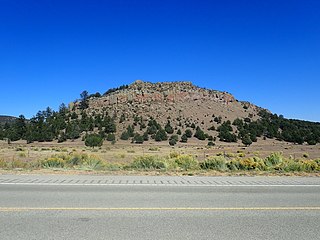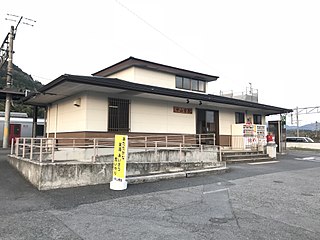Further reading
- Vickers-Rich, Patricia & Rich, Thomas Hewett (1993); Wildlife of Gondwana. Reed. ISBN 0-7301-0315-3
| Coordinates | 33°59′49″N130°48′55″E / 33.9970°N 130.8153°E |
|---|---|
| Composition | |
| Palaeontological Formation | |
The Yamaga Formation is a palaeontological formation located in Japan. It dates to the Upper Oligocene period. [1]

Yamaga is a city in Kumamoto Prefecture, Japan. The city was founded on April 1, 1954.
Yamaga may refer to:

Yamaga Sokō was a Japanese military writer and philosopher under the Tokugawa shogunate of Edo period in Japan. As a scholar he applied the Confucian idea of the "superior man" to the samurai class of Japan. This became an important part of the samurai way of life and code of conduct.

Rhynchippus is an extinct genus of notoungulate mammals from the Late Oligocene of South America. The genus was first described by Florentino Ameghino in 1897 and the type species is R. equinus, with lectotype MACN A 52–31. Fossils of Rhynchippus have been found in the Agua de la Piedra and Sarmiento Formations of Argentina, the Salla and Petaca Formations of Bolivia, the Tremembé Formation of Brazil, and the Moquegua Formation of Peru.

Matsumoto Yamaga Football Club or simply Matsumoto Yamaga FC is a Japanese football (soccer) club based in the city of Matsumoto, located in the Nagano Prefecture. The club currently plays in the J3 League, Japanese third tier of professional football.

Yamaga Station is a passenger railway station located in the city of Ayabe, Kyoto Prefecture, Japan, operated by West Japan Railway Company.

Copepteryx is an extinct genus of flightless bird of the family Plotopteridae, endemic to Japan during the Oligocene living from 28.4 to 23 mya, meaning it existed for approximately 5.4 million years.
Emuarius is an extinct genus of casuariiform flightless bird from Australia that lived during the early Miocene and late Oligocene. It is one of two known genera of emu. There are two known species in the genus, Emuarius gidju and Emuarius guljaruba. The birds in this genus are known as emuwaries. This name comes from a combination of emu and cassowary. This is due to its cassowary-like skull and femur and emu-like lower leg and foot. Because of these similarities it is phylogenetically placed between cassowaries and emus.
Ashorocetus is a monotypic genus of an extinct primitive baleen whale of the family Aetiocetidae. It was named by Barnes et al. 1995, and contains one species, A. eguchii. Fossils of this whale are found from the Chattian Morawan formation, near Ashoro, of upper Oligocene Hokkaido, Japan. Ashorocetus eguchii was described based on a partial skull and is named after the type locality and Kenichiro Eguchi of the Ashoro Museum of Paleontology.

The Breda Formation is a geologic formation in the subsurface of the Netherlands. The formation consists of marine glauconiferous sands and clays that were deposited during the Miocene epoch. Although the formation is not very rich in fossils, sometimes bones of fishes, mammals, shells and shark teeth are found.
The Iwaki Formation is a palaeontological formation located in Iwaki, Fukushima, Japan. It dates to Eocene and early Oligocene periods. The formation contains three families of Artiodactyla–Anthracotheriidae, Entelodontidae, and Hypertragulidae.
The Kishima Group is a group of palaeontological geological formations located in Japan.

The Mogollon-Datil volcanic field is a large silicic volcanic field in western New Mexico. It is a part of an extensive Eocene to Oligocene volcanic event which includes the San Juan volcanic field in southwestern Colorado, the Trans-Pecos volcanic field in west Texas and north central Mexico, the Boot Heel volcanic field in the bootheel of southwestern New Mexico and adjacent areas of Arizona and Mexico; and the vast volcanic field of the Sierra Madre Occidental of western Mexico. The Mogollon-Datil volcanic field was formed in "four discrete pulses representing synchronized activity of two separate cauldron complexes".

Naka-Yamaga Station is a railway station on the Nippō Main Line operated by Kyūshū Railway Company in Kitsuki, Ōita, Japan.
The Bouldnor Formation is a geological formation in the Hampshire Basin of southern England. It is the youngest formation of the Solent Group and was deposited during the uppermost Eocene and lower Oligocene.
Eomysticetus is an extinct genus of baleen whale from the late Oligocene (Chattian) Chandler Bridge Formation of South Carolina.
Parga Formation is a geological formation of sedimentary rock in south-central Chile. The sediments of the formation were deposited during the Late Oligocene and Middle Miocene epochs. The formation's lower sections are made up of conglomerate, sandstone and mudstone some of which is rich in organic material. Additionally there are thin beds of tuff and coal. The formation's composition indicates that sedimentation occurred in an estuarine (paralic) and marine environments. Stratigraphically it overlies the Bahía Mansa Metamorphic Complex and is similar in age and type to Lacui Formation to the south and Cheuquemó and Santo Domingo Formation to the north. It is overlain across an angular unconformity by Pliocene or Quaternary sediments. The formation is intruded by porphyritic trachyte of Oligocene to Miocene age. The outcrops of the formation are restricted to a NW-SE strip near Caleta Parga north of the estuary of Maullín River.

Yamaga Domain was a feudal domain under the Tokugawa shogunate of Edo period Japan, located in Tanba Province in what is now the west-central portion of modern-day Kyoto Prefecture. It was centered around Yamaga jin'ya in what is now the Hirose neighborhood of the city of Ayabe, Kyoto.
Empeirodytes is an extinct genus of Plotopteridae, a family of large flightless bird known from the Late Eocene to the Early Miocene of the West Coast of the United States, British Columbia and Japan. Remains associated with Empeirodytes have been found in Oligocene rocks of the Ashiya Group, on the islands of Ainoshima and Kaijima, near Kitakyushu, Japan.